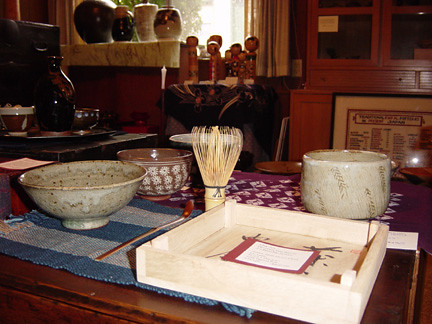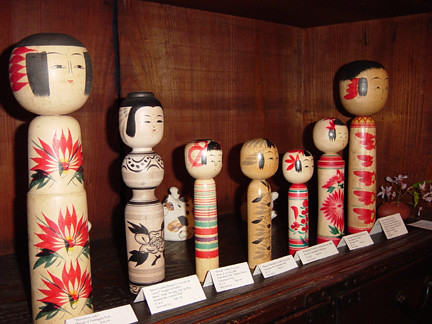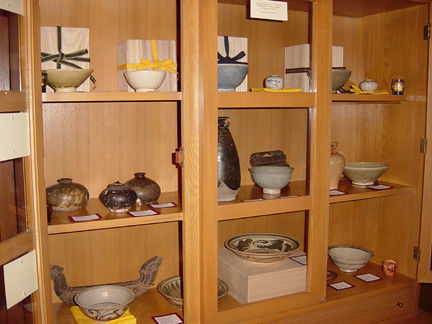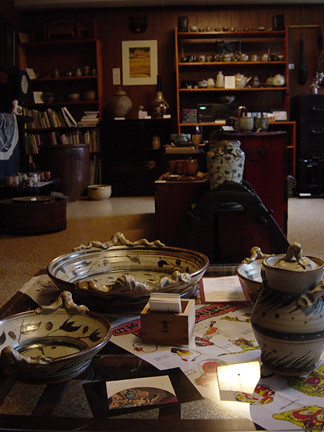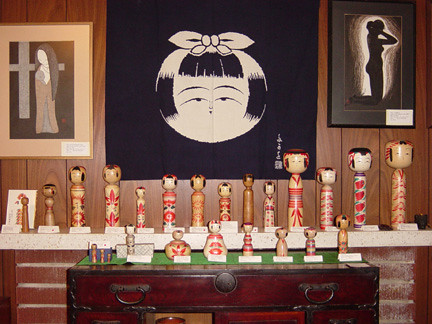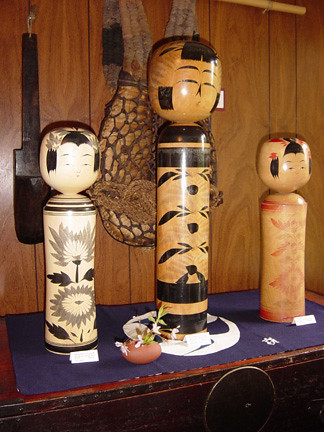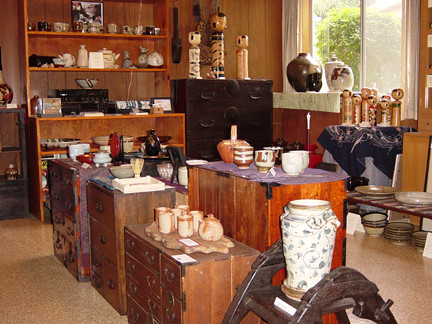Our collection includes antique furniture (such as tansu,) antique through contemporary pottery from Japan, SE Asia, and America; folk textiles, woodblock prints, and other "komingu" (daily use items.) Contemporary pottery, prints, and other works are made by craftspeople inspired by Mingei, as well as wabi-sabi philosophy and aesthetics. We also retail a wide variety of Japanese tea and teawares, and promote tea education, through our Charaku Fine Japanese Tea website, www.charaku-tea.com.
Monday, March 21, 2005
Dentou Kokeshi
Legends about the origins of kokeshi are difficult to prove, but they are thought to have possibly been a totemic type of stand-in for infants and children in old NE Japan. This area was at one time one of the most impoverished and environmentally harshest regions of the country. Infant mortality was high, possibly more so among females as we can assume that in this agricultural setting, males were valued more and better taken care of.
After a safe delivery, or a healthy upbringing, the doll could be desroyed by burning or tossing in a river. This was a common practice with other types of dolls in Japan known as 'amagatsu' (used by the aristocracy) and houko (used by commoners.) Still today, we can find 'kokeshi ohaka' (kokeshi cemetaries) at a few temples in NE Japan, where older, unused kokeshi dolls can be brought for burning. And, ritual burning at sea of dolls and children's toys is another practice still carried out in many parts of Japan.
What we do know for sure is that kokeshi were actual folk toys for children of Tohoku, which was also well known for itinerant woodcrafters, and the spare time in the long, cold winter months to pursue such craft works as weaving, dying, embroidery, woodworking, and clay/paper/wood doll making. As such, they are usually included in the genre of craft items known as "mingei," or folk craft.
Today, kokeshi are purchased by locals and tourists alike, mainly at the many hotspring resorts dotted around Tokoku that have kept this traditional craft alive, mostly passed down from father to son. Each locale has its own style, pattern, color combinations, etc. But, successive generations of kokeshi artisans have also been able to incorporate their own touches rather than merely copying their forefathers' work. By repeating the pattern of their ancestors through long apprenticeships and countless repetitions on a theme, the designs do eventually become their own. This reliance on what Folk Craft Movement founder, Yanagi Soetsu called the "Other Power" ('tariki' in the Buddhist sense) is what makes these dolls a link to tradition, as well as a contemporary product of aesthetic beauty.
Being the collectible item today that is produced and used mostly for display purposes, kokeshi can no longer be considered a "folk toy." However, the spirit of the artisan is what's important to me here. There is another version of kokeshi today called "creative," "modern," or "art" kokeshi. These are not bound by traditional designs and patterns, but are artistic interpretations by individual artists, creating a name for themselves. Dentou Kokeshi, though often signed by the artisan, are still representative first and foremost of their region and tradition.
Currently, I have available a large collection of vintage and new dentou kokeshi reaching back to the war years up to pieces purchased about 5 years ago. For most, I have been able to identify the maker, and where so have their birth or death date available from references as well. Please feel free to contact me with any questions or comments. Are you a kokeshi collector as well? Let's start a club!
Thanks for reading,
Tatsuo Tomeoka
WaSabiDou Antiques & Folk Crafts
tatsuo@mingei-wasabidou.com
(under construction) www.mingei-wasabidou.com
Lee Love Yunomi, Showroom (March '05)
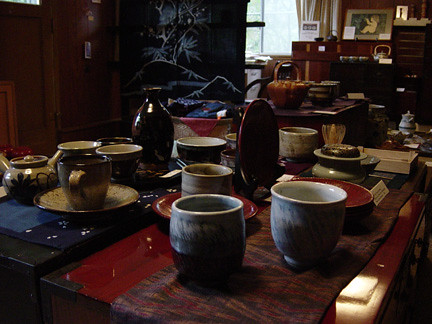
More pots in the showroom. In the foreground are 2 yunomi (tea cups) by
Mashiko potter (by way of Minnesota) and good friend, Lee Love. Here,
you can see his utilization of the Zogan (inlay) technique in homage to
his sensei (teacher,) Shimaoka Tatsuzo. Mr. Shimaoka was designated a
National Living Treasure in Japan for his technique of Jomon Zogan
(rope-impressed inlay,) inspired by the braids his father made as a
braid craftsman, several years after his (Shimaoka-sensei's) own
apprenticeship under another well-known (Ningen Kokuho) National Living
Treasure, Hamada Shoji.
Tuesday, March 15, 2005
Japanese Antiques, Dolls, Pottery SALE
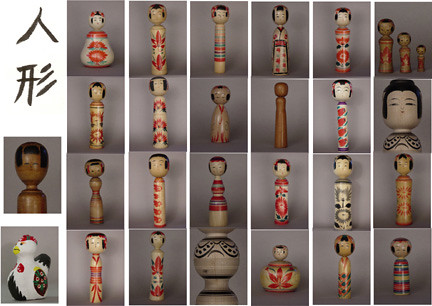
Spring Sale
WaSabiDou: Antiques & Folk Crafts
All tansu will be
discounted 15%, & all
pottery, prints, & textiles
will be 10% off.
Plus: A vintage
collection of dentou
(traditional)
kokeshi from Northeastern
Japan will be featured.
These playful folk toys, made by
generations of
artisans, are wonderful examples of mingei
tradition still alive in rural
Japan.
(S,Su,M)March 19,20, 21 & (F,S)March 25,26.
11:00am to 5:00pm daily, or by appointment.
127 NW 136th Street,
Seattle, WA 98177
info:206.660.4189 or
<tatsuo@mingei-wasabidou.com>
www.mingei-wasabidou.com
This year has welcomed an early spring to Seattle! The Cherry Blossoms are already in full bloom in most parts. I'll be holding an open house sale over the next few weeks; with discounted prices on tansu, ceramics, and more. As seen on the attachment, there will also be several (about 40) vintage kokeshi for sale, as well as papier mache folk toy roosters for the current Asain zodiac year. These, and the kokeshi, are from my family's region of Tohoku (Northeastern Japan,) and convey the folk sensibilities of rural Japan. Hope you can drop by to visit over a cup of tea, and exchange views on antiques and folk crafts.
Please feel free to forward this notice to anyone you think would also be interested. I'm building a few distribution lists, so if you happen to receive this twice, my apologies in advance. Thanks.
A web page is currently under construction at www.mingei-wasabidou.com and new inventory items will be added daily (between feedings and changings of a new baby due any day now.) in hopes of having 300-400 up in the next month Please stop in regulalry. Thanks for your support.
Best regards,
Tatsuo Tomeoka
WaSabiDou Antiques and Folk Crafts
